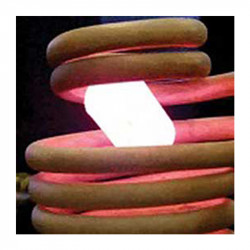

Category


Photos are for informational purposes only. View product specification
please use latin characters
Achieving minimal contamination of conductive material during manufacturing proves to be a difficult task. One successful technique is known as levitation melting. This technique produces small quantities of electrically conductive material by suspending and then melting the material with induction heating.
Once the material has melted, the RF power is shut off, and the molten mass can be dropped or forced into a mold for forming. Potential for this application lies in the jewelry, dental, electronics, and aerospace research industries.
Modern induction heating provides reliable, repeatable, non-contact and energy-efficient heat in a minimal amount of time. Solid state systems are capable of heating very small areas or parts within precise production tolerances, without disturbing individual metallurgical characteristics.
Solid state RF induction power supplies are ideal candidates for levitation melting. Levitation melting relies on a complex balancing act involving three- dimensional forces. By using solid state equipment, consistent and reliable melting cycles are produced through accurate frequency tuning and power control.
Typical RF power supplies for levitation melting range from 1 to 5 kW, depending on the material and application requirements.
Are you interested in this product? Do you need additional information or individual pricing?
Achieving minimal contamination of conductive material during manufacturing proves to be a difficult task. One successful technique is known as levitation melting. This technique produces small quantities of electrically conductive material by suspending and then melting the material with induction heating.
Once the material has melted, the RF power is shut off, and the molten mass can be dropped or forced into a mold for forming. Potential for this application lies in the jewelry, dental, electronics, and aerospace research industries.
Modern induction heating provides reliable, repeatable, non-contact and energy-efficient heat in a minimal amount of time. Solid state systems are capable of heating very small areas or parts within precise production tolerances, without disturbing individual metallurgical characteristics.
Solid state RF induction power supplies are ideal candidates for levitation melting. Levitation melting relies on a complex balancing act involving three- dimensional forces. By using solid state equipment, consistent and reliable melting cycles are produced through accurate frequency tuning and power control.
Typical RF power supplies for levitation melting range from 1 to 5 kW, depending on the material and application requirements.
Your review appreciation cannot be sent
Report comment
Report sent
Your report cannot be sent
Write your review
Review sent
Your review cannot be sent
